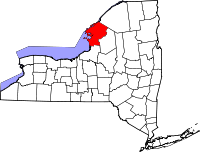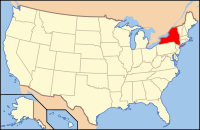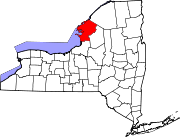- Jefferson County, New York
-
Jefferson County, New York 
Location in the state of New York
New York's location in the U.S.Founded 1805 Seat Watertown Area
- Total
- Land
- Water
1,857 sq mi (4,810 km²)
1,272 sq mi (3,294 km²)
585 sq mi (1,515 km²), 31.49%Population
- (2010)
- Density
116,229
91/sq mi (35.2/km²)Website www.co.jefferson.ny.us Jefferson County is a county located in the U.S. state of New York. As of the 2010 census, the population was 116,229. It is named after Thomas Jefferson, third President of the United States of America, and president at the time the county was created in 1805. Its county seat is Watertown.
Contents
History
When counties were established in the Province of New York in 1683, the present Jefferson County was part of Albany County. This was an enormous county, including the northern part of New York State as well as all of the present State of Vermont and, in theory, extending westward to the Pacific Ocean. This county was reduced in size on July 3, 1766 by the creation of Cumberland County, and further on March 16, 1770 by the creation of Gloucester County, both containing territory now in Vermont.
On March 12, 1772, what was left of Albany County was split into three parts, one remaining under the name Albany County. One of the other pieces, Tryon County, contained the western portion (and thus, since no western boundary was specified, theoretically still extended west to the Pacific). The eastern boundary of Tryon County was approximately five miles west of the present city of Schenectady, and the county included the western part of the Adirondack Mountains and the area west of the West Branch of the Delaware River. The area then designated as Tryon County now includes 37 counties of New York State. The county was named for William Tryon, colonial governor of New York.
In the years subsequent to 1776, most of the Loyalists in Tryon County fled to Canada. In 1784, following the peace treaty that ended the American Revolutionary War, the name of Tryon County was changed to Montgomery County to honor the general, Richard Montgomery, who had captured several places in Canada and died attempting to capture the city of Quebec, replacing the name of the hated British governor.
In 1789, the size of Montgomery County was reduced by the splitting off of Ontario County from Montgomery. The actual area split off from Montgomery County was much larger than the present county, also including the present Allegany, Cattaraugus, Chautauqua, Erie, Genesee, Livingston, Monroe, Niagara, Orleans, Steuben, Wyoming, Yates, and part of Schuyler and Wayne Counties.
Jefferson County is part of Macomb's Purchase of 1791.
In 1791, Herkimer County was one of three counties split off from Montgomery (the other two being Otsego, and Tioga County). This was much larger than the present county, however, and was reduced by a number of subsequent splits. The first one of these, in 1794, produced Onondaga County. This county was larger than the current Onondaga County, including the present Cayuga, Cortland, and part of Oswego Counties.
Oneida County (as well as a part of Chenango County), was split off from Herkimer County in 1798.
Jefferson County was split off from Oneida County in 1805. In 1817, Carleton Island, captured from the British in the War of 1812, was annexed to the county.
Geography
Jefferson County is in northeastern New York State, adjacent to the area where the Saint Lawrence River exits Lake Ontario. It is northeast of Syracuse, and northwest of Utica. The county is at the international border with Canada.
The Black River, which empties into Lake Ontario, is an important waterway in the county. Part of the Tug Hill Plateau is in the southern part of the county.
The county also includes nearby islands in the St. Lawrence River, including such large islands as Carleton Island, Grindstone Island, and Wellesley Island.
According to the U.S. Census Bureau, the county has a total area of 1,857 square miles (4,809.6 km2), of which 1,272 square miles (3,294.5 km2) is land and 585 square miles (1,515.1 km2) (31.49%) is water.
Adjacent counties
- St. Lawrence County, New York - northeast
- Lewis County, New York - southeast
- Oswego County, New York - southwest
- Leeds and Grenville United Counties, Ontario - north
- Frontenac County, Ontario - northwest
Major highways
 Interstate 81
Interstate 81 U.S. Route 11
U.S. Route 11 New York State Route 3
New York State Route 3 New York State Route 3A
New York State Route 3A New York State Route 12
New York State Route 12 New York State Route 12E
New York State Route 12E New York State Route 26
New York State Route 26 New York State Route 37
New York State Route 37 New York State Route 180
New York State Route 180
Government
Legislative authority is vested in the county Board of Legislators which consists of 15 members each elected from single member districts. Legislative District Maps Currently, there are 13 Republicans and 2 Democrats.
County Board of Legislators
- 01 - Michael Docteur (R)
- 02 - Robert J. Thomas (R)
- 03 - Philip N. Reed, Sr. (R)
- 04 - Allen Drake (D)
- 05 - Steven Harter (R)
- 06 - Gino Zando (R)
- 07 - Kent Burto (R)
- 08 - James Nabywaniec (R)
- 09 - Barry Ormsby (R)
- 10 - Michael Behling (R)
- 11 - Robert D. Ferris (R)
- 12 - Carolyn D. Fitzpatrick (R), Vice Chair
- 13 - Scott Gray (R)
- 14 - Jennie Adsit (R)
- 15 - James St. Croix (D)
Demographics
Historical populations Census Pop. %± 1810 15,140 — 1820 32,952 117.6% 1830 48,493 47.2% 1840 60,984 25.8% 1850 68,153 11.8% 1860 69,825 2.5% 1870 65,415 −6.3% 1880 66,103 1.1% 1890 68,806 4.1% 1900 76,748 11.5% 1910 80,382 4.7% 1920 82,250 2.3% 1930 83,574 1.6% 1940 84,003 0.5% 1950 85,521 1.8% 1960 87,835 2.7% 1970 88,508 0.8% 1980 88,151 −0.4% 1990 110,943 25.9% 2000 111,738 0.7% 2010 116,229 4.0% Source[1][2] As of the census[3] of 2000, there were 111,738 people, 40,068 households, and 28,127 families residing in the county. The population density was 88 people per square mile (34/km²). There were 54,070 housing units at an average density of 42 per square mile (16/km²). The racial makeup of the county was 88.71% White, 5.83% Black or African American, 0.53% Native American, 0.92% Asian, 0.14% Pacific Islander, 2.05% from other races, and 1.82% from two or more races. 4.19% of the population were Hispanic or Latino of any race. 14.1% were of Irish, 12.8% German, 11.3% English, 10.6% American, 8.5% French and 8.5% Italian ancestry according to Census 2000. 93.2% spoke English and 3.5% Spanish as their first language.
There were 40,068 households out of which 37.20% had children under the age of 18 living with them, 55.60% were married couples living together, 10.40% had a female householder with no husband present, and 29.80% were non-families. 24.40% of all households were made up of individuals and 10.10% had someone living alone who was 65 years of age or older. The average household size was 2.58 and the average family size was 3.07.
In the county the population was spread out with 26.50% under the age of 18, 11.80% from 18 to 24, 31.30% from 25 to 44, 19.10% from 45 to 64, and 11.30% who were 65 years of age or older. The median age was 32 years. For every 100 females there were 107.30 males. For every 100 females age 18 and over, there were 108.50 males.
The median income for a household in the county was $34,006, and the median income for a family was $39,296. Males had a median income of $28,727 versus $21,787 for females. The per capita income for the county was $16,202. About 10.00% of families and 13.30% of the population were below the poverty line, including 16.80% of those under age 18 and 9.20% of those age 65 or over.
Cities, towns, villages, and other communities
- Adams (town) Adams history
- Adams (village)
- Adams Center
- Alexandria (town)
- Alexandria Bay (village)
- Antwerp (town)
- Antwerp (village)
- Black River (village)
- Brownville (town)
- Brownville (village)
- Calcium
- Cape Vincent (town)
- Cape Vincent (village)
- Carthage (village)
- Champion (town)
- Chaumont (village)
- Clayton (town)
- Clayton (village)
- Deferiet (village)
- Depauville
- Dexter (village)
- Ellisburg (town)
- Ellisburg (village)
- Evans Mills (village)
- Felts Mills (hamlet)
- Fishers Landing
- Fort Drum (federal military installation)
- Glen Park (village)
- Great Bend
- Henderson (town)
- Herrings (village)
- Hounsfield (town)
- La Fargeville
- Le Ray (town)
- Lorraine (town)
- Lyme (town)
- Mannsville (village)
- Natural Bridge
- Orleans (town)
- Pamelia (town)
- Philadelphia (town)
- Philadelphia (village)
- Redwood
- Rodman (town)
- Rutland (town)
- Sackets Harbor (village)
- Theresa (town)
- Theresa (village)
- Three Mile Bay
- Watertown (town)
- Watertown (city)
- West Carthage (village)
- Wilna (town)
- Worth (town)
- => Designations in parentheses relate to official political status.
Additional county information
Jefferson County contains part of the Thousand Islands and borders the St. Lawrence River.
Jefferson Community College in Watertown provides higher education within the county.
The U.S. Tenth Mountain Division is based at Fort Drum.
See also
- Dewolf Point State Park
- List of counties in New York
- National Register of Historic Places listings in Jefferson County, New York
References
- ^ New York State Department of Economic Development
- ^ http://factfinder2.census.gov
- ^ "American FactFinder". United States Census Bureau. http://factfinder.census.gov. Retrieved 2008-01-31.
External links
- Jefferson County webpage
- Jefferson County at the Open Directory Project
- Guide to historical information
- Summary history of Jefferson County, NY and its towns
- Jefferson County information
- Jefferson County history & genealogy
- Jefferson County History with pics and links
- Jefferson County history pages
- Alexandria Bay in Jefferson County - Local Resource & News Website
- Old Abandoned Buildings of Northern NY The urban decay of upstate NY, in pictures from the area.
- Early Jefferson County Biographies
- Jefferson County & Watertown wiki
- List of walking, hiking, biking trails and areas in Jefferson County
- Jefferson County Flickr Group

Frontenac County, Ontario, Canada Leeds and Grenville United Counties, Ontario, Canada St. Lawrence County 
Lake Ontario 
 Jefferson County, New York
Jefferson County, New York 

Oswego County Lewis County Municipalities and communities of Jefferson County, New York City Towns Adams | Alexandria | Antwerp | Brownville | Cape Vincent | Champion | Clayton | Ellisburg | Henderson | Hounsfield | Le Ray | Lorraine | Lyme | Orleans | Pamelia | Philadelphia | Rodman | Rutland | Theresa | Watertown | Wilna | Worth
Villages Adams | Alexandria Bay | Antwerp | Black River | Brownville | Cape Vincent | Carthage | Chaumont | Clayton | Deferiet | Dexter | Ellisburg | Evans Mills | Glen Park | Herrings | Mannsville | Philadelphia | Sackets Harbor | Theresa | West Carthage
CDPs Adams Center | Calcium | Depauville | Fort Drum | Great Bend | La Fargeville | Natural Bridge | Redwood
Other
hamletsFelts Mills | Fishers Landing | Oxbow
Categories:- New York counties
- Jefferson County, New York
- 1805 establishments in the United States
- Populated places established in 1805
- Thousand Islands
Wikimedia Foundation. 2010.

